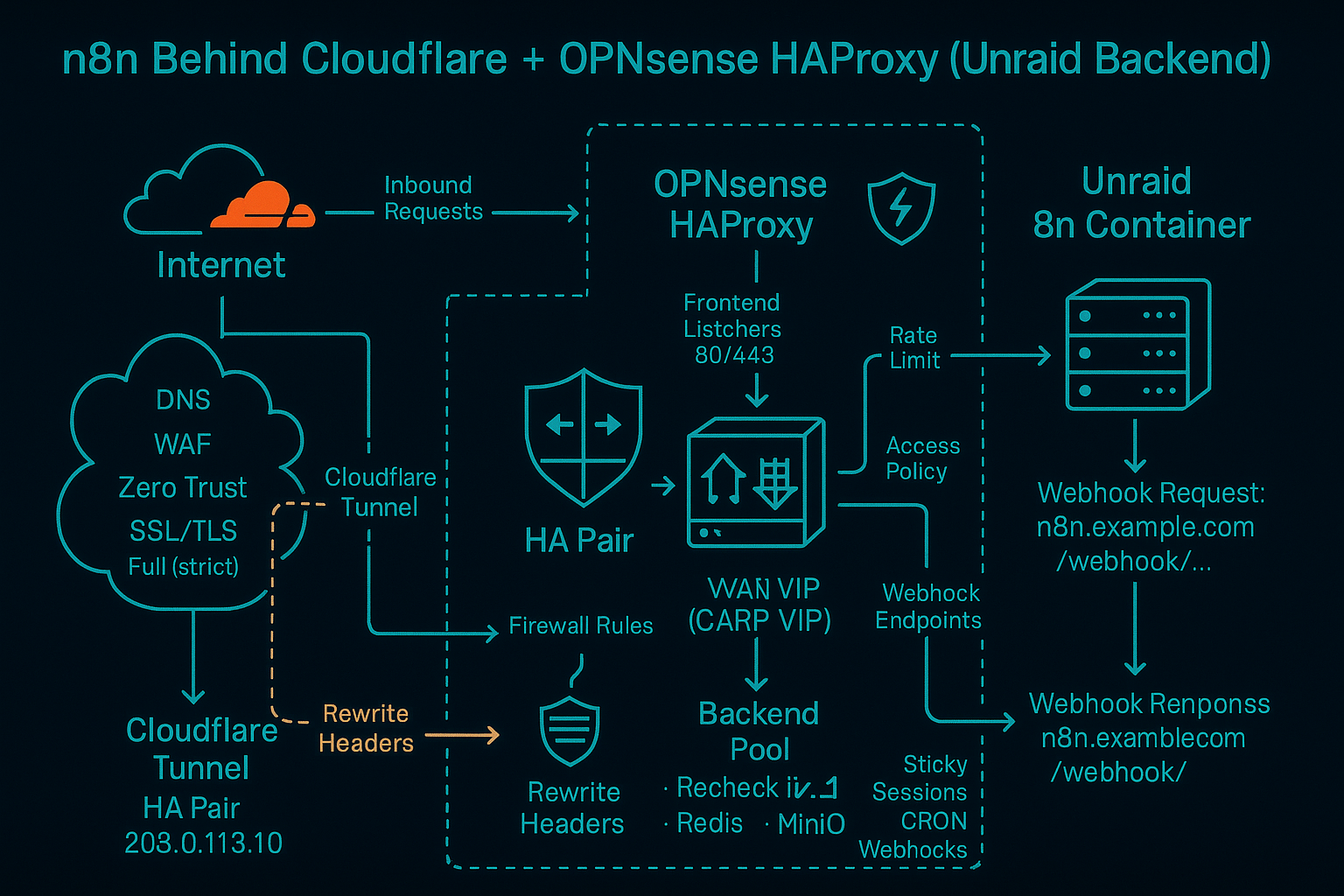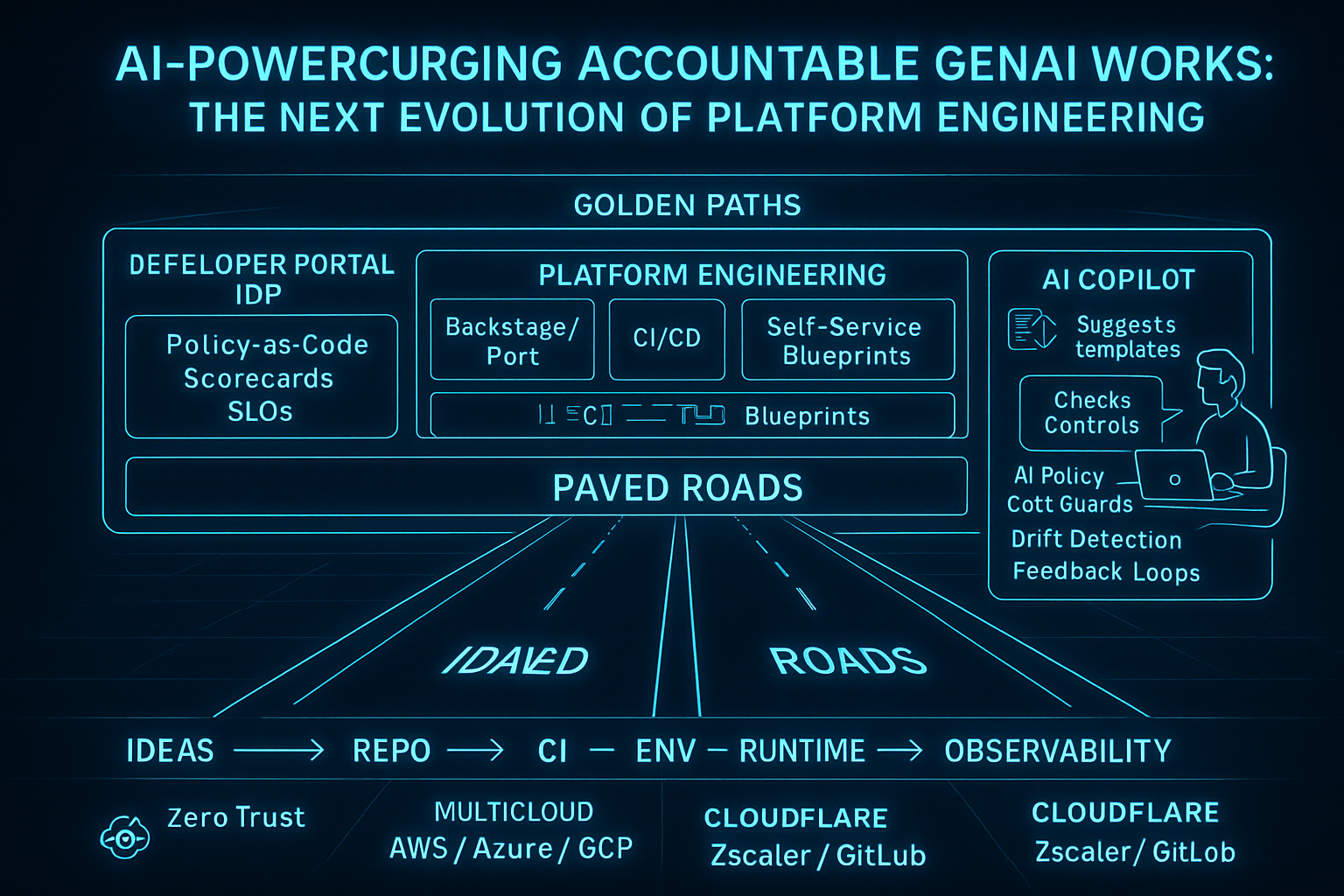n8n Behind Cloudflare + OPNsense HAProxy (Unraid Backend)
Step-by-step topology for exposing n8n through Cloudflare, OPNsense HAProxy, and Unraid with the right headers, WebSocket support, and TLS expectations.

n8n behind Cloudflare + OPNsense HAProxy (Unraid backend)
Expose
n8nat https://n8n.example.com through Cloudflare → OPNsense/HAProxy → Unraid (Docker) with correct headers and WebSocket support. Avoids common pitfalls that cause CSRF “Origin header does NOT match…” and HTTP 503.
Topology

Figure 1: n8n Network Architecture - Cloudflare → OPNsense → Unraid
Browser ──HTTPS──► Cloudflare (proxy: orange cloud)
│
▼
OPNsense (HAProxy, TLS offload @ :443)
│
▼
Unraid (Docker) → n8n container (HTTP :5678)🔧 Key Components
- Cloudflare: DNS proxy with DDoS protection and SSL termination
- OPNsense + HAProxy: Load balancer with TLS offloading
- Unraid Docker: Containerized n8n instance
Prerequisites
- Cloudflare DNS:
n8n.example.com→ WAN IP of OPNsense (proxied, orange cloud). - OPNsense with HAProxy plugin.
- Unraid Docker n8n container reachable on LAN (e.g.,
10.0.3.129:5678). - Valid TLS cert on OPNsense (e.g.,
*.example.comvia ACME client).
1) n8n container (Unraid) — required environment variables
Set these on the n8n container and recreate/apply:
N8N_HOST = n8n.example.comN8N_PORT = 443N8N_PROTOCOL = httpsN8N_EDITOR_BASE_URL = https://n8n.example.com/WEBHOOK_URL = https://n8n.example.com/N8N_SECURE_COOKIE = true
Optional (noise reduction):
N8N_DIAGNOSTICS_ENABLED = falseN8N_DISABLE_VERSION_NOTIFICATIONS = true
Verify inside the running container:
docker exec -it n8n env | grep -E 'N8N_|WEBHOOK_URL'If you ever saw “Expected: …” in logs, once envs are correct do this once:
docker stop n8n
rm -f /mnt/user/appdata/n8n/config
docker start n8nThen hard-refresh your browser (Ctrl+F5 / Cmd+Shift+R).
2) OPNsense HAProxy — Backend (to n8n)
Real Server
- Name:
n8n_server - IP/FQDN:
10.0.3.129 - Port:
5678 - SSL: OFF (backend is plain HTTP)
- Mode: active
Backend Pool
- Name:
n8n_backend - Mode: HTTP
- Servers:
n8n_server - Health check: HTTP GET
/, expect 200–399 - HTTP(S) settings: enable X-Forwarded-For
- Persistence: None
Sanity from LAN:
curl -sS http://10.0.3.129:5678/ | head -n 53) OPNsense HAProxy — Conditions
Create in Rules & Checks → Conditions:
host_n8n→ Host matches →n8n.example.comis_websocket_upgrade→ HTTP request header matches → HeaderUpgradeequalswebsocket(case-insensitive)
4) OPNsense HAProxy — Rules
Create in Rules & Checks → Rules:
set_xfp_https→http-request header setX-Forwarded-Proto =httpsset_xfh_host→http-request header set X-Forwarded-Host %[req.hdr(host)]ws_upgrade(conditionis_websocket_upgrade) →http-request header set Upgrade websocketws_connection_upgrade(conditionis_websocket_upgrade) →http-request header set Connection upgraderoute_to_n8n(conditionhost_n8n) → Use specified Backend Pool →n8n_backend- (Port 80 only)
redirect_to_https_all→http-request redirect https://%[req.hdr(host)]%[req.uri](code 301)
5) OPNsense HAProxy — Public Services (listeners)
Keep only one listener bound to 0.0.0.0:443. Disable duplicates to avoid conflicts.
Port 80 — redirect only
- Name:
public_facing_pool_80 - Listen:
0.0.0.0:80 - Default Backend: None
- Rules:
redirect_to_https_all(only this) - Basic Auth / Prometheus: Off
Port 443 — TLS offload + routing
- Name:
public_facing_pool_443 - Listen:
0.0.0.0:443 - SSL offloading: On, certificate
*.example.com - Client Certificate Auth: Off (unless you require mTLS)
- Basic Authentication: Off (unless intentional)
- Rules attached:
set_xfp_httpsset_xfh_hostws_upgradews_connection_upgraderoute_to_n8n(Host →n8n_backend)
Debug tip: If you get a 503, temporarily set Default Backend = n8n_backend on 443 to prove routing, then switch back to None once host routing works.
6) Cloudflare
- DNS:
n8n.example.com→ WAN IP of OPNsense (proxied). - SSL/TLS mode: Full (strict) (not Flexible).
- WebSockets: supported automatically over 443.
7) Verification
# 80 should redirect to 443
curl -I http://n8n.example.com
# → HTTP/1.1 301 Moved Permanently … Location: https://n8n.example.com/...
# 443 should succeed (200 / login page), not 503
curl -I https://n8n.example.com
# Backend from LAN
curl -sS http://10.0.3.129:5678/ | head -n 58) Troubleshooting
-
503 on HTTPS
- Multiple 443 listeners on
0.0.0.0:443(disable extras). - Backend wrong/unreachable.
- Missing host-route rule on 443.
- Multiple 443 listeners on
-
“Origin header does NOT match the expected origin”
- Missing/misspelled n8n env vars (verify
N8N_*andWEBHOOK_URL). - Tiny settings file overriding envs → remove once (see step 1).
- Browser cache: hard-refresh / incognito.
- Missing/misspelled n8n env vars (verify
-
WebSocket issues
- Missing HAProxy rules to set
Upgrade: websocketandConnection: upgradewhenUpgrade: websocket.
- Missing HAProxy rules to set
9) Optional hardening
- HSTS on 443:
Strict-Transport-Security: max-age=31536000; includeSubDomains; preload - Add rate limiting/stick tables as needed.
10) Rule quick reference
- redirect_to_https_all →
http-request redirect https://%[req.hdr(host)]%[req.uri](301) - set_xfp_https →
http-request header set X-Forwarded-Proto https - set_xfh_host →
http-request header set X-Forwarded-Host %[req.hdr(host)] - ws_upgrade (if
Upgrade: websocket) →http-request header set Upgrade websocket - ws_connection_upgrade (if
Upgrade: websocket) →http-request header set Connection upgrade - route_to_n8n (if Host
n8n.example.com) → Use backend:n8n_backend
Related Posts

Paved Roads: AI-Powered Platform Engineering That Scales Trust
How golden paths, AI copilots, and zero-trust guardrails transform platform engineering from gatekeeper to enabler—shipping accountable GenAI workflows at scale.
Comments & Discussion
Discussions are powered by GitHub. Sign in with your GitHub account to leave a comment.